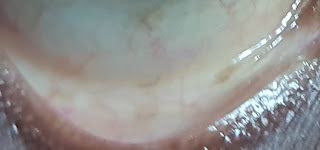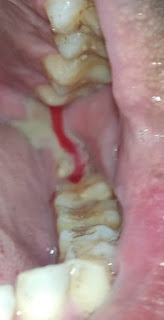1801006175 - LONG CASE
This is an online e log book to discuss our patient de-identified health data shared after taking his / her / guardians signed informed consent. Here we discuss our individual patients problems through series of inputs from available global online community of experts with an aim to solve those patients clinical problem with collective current best evident based input.
This E blog also reflects my patient centered online learning portfolio and your valuable inputs on the comment box is welcome.
I have been given this case to solve in an attempt to understand the topic of " patient clinical data analysis" to develop my competency in reading and comprehending clinical data including history, clinical findings, investigations and come up with diagnosis and treatment plan.
CHIEF COMPLAINTS:
A 40 Yr old male resident of Krishnapuram, Nalgonda dist, field assistant by occupation presented with the chief complaints of:
- pain abdomen since 6 days
- nausea and vomiting since 6 days
- abdominal distention since 5 days
Patient was apparently asymptomatic 7 days ago, then he developed pain in abdomen of epigastric region which is severe, squeezing type, constant, radiating to the back and aggravated on doing any activity and relieved on sitting and bending forward.
He developed nausea and vomiting which was 10-15 episodes which was non bilious, non projectile and food as content.
and then he developed abdominal distention 6 days ago which is sudden onset, gradually progressive to current state.
no history of decreased urine output, facial puffiness,edema
no history of fever, shortness of breath, cough
PAST HISTORY :
history of diabetes since 5 years
history of hypertension since 5 years
no history of asthma,TB,epilepsy and thyroid disorders.
PERSONAL HISTORY:
Appetite: decreased
Diet: mixed
Sleep: adequate
Bowel and Bladder movements : regular
Addictions: history of alcohol intake for 5 years
DAILY ROUTINE:
He works as a field assistant under NREGS, nalgonda from last 15 years, he supervises around 200-250 workers daily. He goes to his work on his bike at 9 in the morning and comes back home around 5 in the evening.
Since 10 years, the work stress made him to take alcohol with his colleagues from the work and consumes around 60ml of whiskey on a daily basis
10 years ago- started drinking alcohol
↓
3 years ago- admitted in a hospital with the similar complaints, got treated and discharged after 5 days
↓
since 6 days, he couldn't cope up the work stress,consuming alcohol continuously taking around 500 ml daily, skipping food and not going to home
↓
developed pain abdomen and nausea,vomiting
FAMILY HISTORY:
History of diabetes to patient's mother since 14 years
History of diabetes to patient's father since 15 years
TREATMENT HISTORY:
metformin (class of drug:biguanide )plus glimiperide(sulfonylurea)
telmisartan 40 mg
GENERAL EXAMINATION:
Patient is conscious, coherent, cooperative and well oriented to time,place and person
Adequately built and Adequately nourished
Pallor - Absent
In lft there is elevation of bilirubin , total protein .
Icterus -Absent
Clubbing - Absent
Cyanosis - Absent
Lymphadenopathy -Absent
Pedal Edema - Absent
Vitals :
Temperature - 99 F
Pulse Rate - 80 beats per minute , Regular Rhythm, Normal In volume, No Radio-Radial or Radio-Femoral Delay
Blood Pressure - 130/90 mmHg measured in the left upper limb, in sitting position.
Respiratory Rate - 13 breaths per minute and regular
SYSTEMIC EXAMINATION:
Patient examined in a well lit room, after taking informed consent.
GASTROINTESTINAL SYSTEM EXAMINATION
Oral Cavity: Normal
Per Abdomen :
Inspection -
Shape - Uniformly Distended
Umbilicus - displaced downwards
Skin - No scars, sinuses, scratch marks, striae, no dilated veins, hernial orifices free, skin over the abdomen is smooth
External genitalia - normal
Palpation -
No local rise in temperature, tenderness in epigastric area
Liver not palpable
Spleen not palpable
Kidneys are not palpable
Abdominal Girth - 93 cm
Xiphisternum - Umbilicus Distance - 21 cm
Umbilicus - Pubic Symphysis Distance - 15 cm
Spino-Umbilical Distance - 19 cm and equal on both sides
Percussion -
Shifting Dullness - Present
Liver dullness at 5th intercoastal space along midclavicular line - Normal
Spleen Percussion - Normal
Tidal Percussion - Absent
Fluid thrill: present
Auscultation -
Bowel Sounds - Absent
No Bruit or Venous Hum
CARDIOVASCULAR SYSTEM EXAMINATION
Inspection -
Chest Wall is Symmetrical
Precordial Bulge is not seen
No dilated veins, scars, sinuses
Apical impulse - Not Seen
Jugular Venous Pulse - Not Raised
Palpation -
Apical Impulse - Felt at 5th Intercostal space in the mid clavicular line
No thrills, no dilated veins
Auscultation -
Mitral Area - First and Second Heart Sounds Heard, No other sounds are heard
Tricuspid Area - First and Second Heart Sounds Heard, No other sounds are heard
Pulmonary Area - First and Second Heart Sounds Heard, No other sounds are heard
Aortic Area - First and Second Heart Sounds Heard, No other sounds are heard
Inspection -
Pulmonary Area - First and Second Heart Sounds Heard, No other sounds are heard
Aortic Area - First and Second Heart Sounds Heard, No other sounds are heard
RESPIRATORY SYSTEM EXAMINATION
Inspection -
Chest is symmetrical
Trachea is midline
No retractions
No kyphoscoliosis
No Winging of scapula
No Scars, sinuses, Dilated Veins
All areas move equally and symmetrically with respiration
Palpation -
Trachea is Midline
No tenderness, local rise in temperature
Tactile Vocal Fremitus - Present in all 9 areas
Percussion -
Percussion Right Left
Supra clavicular: resonant resonant
Infra clavicular: resonant resonant
Mammary: resonant Resonant
Axillary: resonant resonant
Infra axillary: resonant resonant
Supra scapular: resonant resonant
Infra scapular: resonant resonant
Inter scapular: resonant resonant
Supra clavicular: resonant resonant
Infra clavicular: resonant resonant
Mammary: resonant Resonant
Axillary: resonant resonant
Infra axillary: resonant resonant
Supra scapular: resonant resonant
Infra scapular: resonant resonant
Inter scapular: resonant resonant
No tenderness
Auscultation -
Auscultation: Right. Left
Supra clavicular:. NVBS NVBS
Infra clavicular: NVBS NVBS
Mammary: NVBS NVBS
Axillary: NVBS NVBS
Infra axillary: NVBS NVBS
Supra scapular: NVBS NVBS
Infra scapular: NVBS NVBS
Inter scapular: NVBS NVBS
Supra clavicular:. NVBS NVBS
Infra clavicular: NVBS NVBS
Mammary: NVBS NVBS
Axillary: NVBS NVBS
Infra axillary: NVBS NVBS
Supra scapular: NVBS NVBS
Infra scapular: NVBS NVBS
Inter scapular: NVBS NVBS
No added sounds
Vocal Resonance in all 9 areas- normal
CENTRAL NERVOUS SYSTEM EXAMINATION
All Higher Mental Functions are intact
No Gait Abnormalities
No Bladder Abnormalities
Neck Rigidity Absent
PROVISIONAL DIAGNOSIS: Ascites secondary to pancreatitis
DIAGNOSIS:
Ascites secondary to Acute Pancreatitis
INVESTGATIONS:
USG ABDOMEN :
mild to moderate ascites is seenAscitic tap done :
Pancreatic ascites is characterized by an amylase level of over 1000 IU/Land protein level greater than 3 g/dL. The calculated serum-ascites albumin gradient (SAAG) is normally less than 1.1 g/dL.
Calculation of SAAG= (serum albumin-acidic fluid albumin) = 4.1-3.3 = 0.8mg/dL
In lft there is elevation of bilirubin , total protein .
Ascitic fluid analysis:
MANAGEMENT
NPO(nothing by mouth)
IV Fluids - N/S (urine output+30ml/hr)
Inj. PANTOP 40 mg IV BD(a proton pump inhibitor,decreases hcl production in stomach and relieves discomfort)
Inj. ZOFER 4 mg IV SOS(antiemetic ,to be taken as and when required)
Inj, PIPTAZ 2.25 mg IV TID(piperacillin,a penicillin antibiotic)
Tab. AMLONG 20 mg PO OD(antihypertensive medication ,a calcium channel blocker)
Tab.LASIX 40 mg BD(a loop diuretic, furosemide )
GRBS every 4th hourly
Inj TRAMADOL 1 amp IV+100 ml NS IV OD(analgesic for pain)
Inj, HUMAN ACTRAPID according to sugars(a short acting insulin as there is a decrease in insulin due to pancreatitis)
Therapeutic paracentesis around 1L
Note :
Some useful information regarding ascites secondary to pancreatitis:
Pancreatic ascites results from a pancreatic duct injury, leading to persistent leakage of pancreatic secretions into the peritoneum. The severity of this condition varies widely. While mild cases of pancreatic ascites resolve spontaneously, persistent pancreatic ascites and infection are associated with significant morbidity and mortality.
A persistent internal fistula into peritoneum causes pancreatic ascites.
Pancreatic necrosis can cause major pancreatic duct injury.
Fistulas from an anterior pancreatic duct disruption allow for pancreatic secretions to empty directly into the peritoneum leading to ascites.
Pancreatic ascites is characterized by an amylase level over 1000 IU/L and protein level greater than 3 g/dL. The calculated serum-ascites albumin gradient (SAAG) is normally less than 1.1 g/dL. This distinguishes from ascites secondary to portal hypertension where amylase levels of ascitic fluid are not elevated, and fluid albumin levels are normally below 1.5 g/dL with a SAAG greater than 1.1 g/dL.
Below are ct images from a case of pancreatic ascites one year apart:
















Comments
Post a Comment